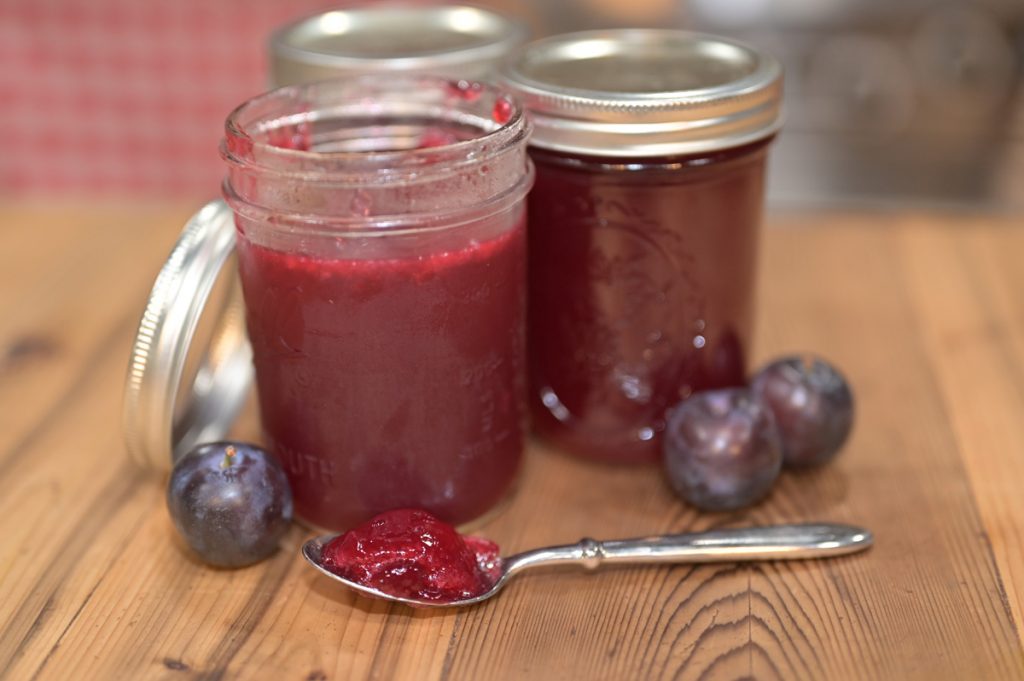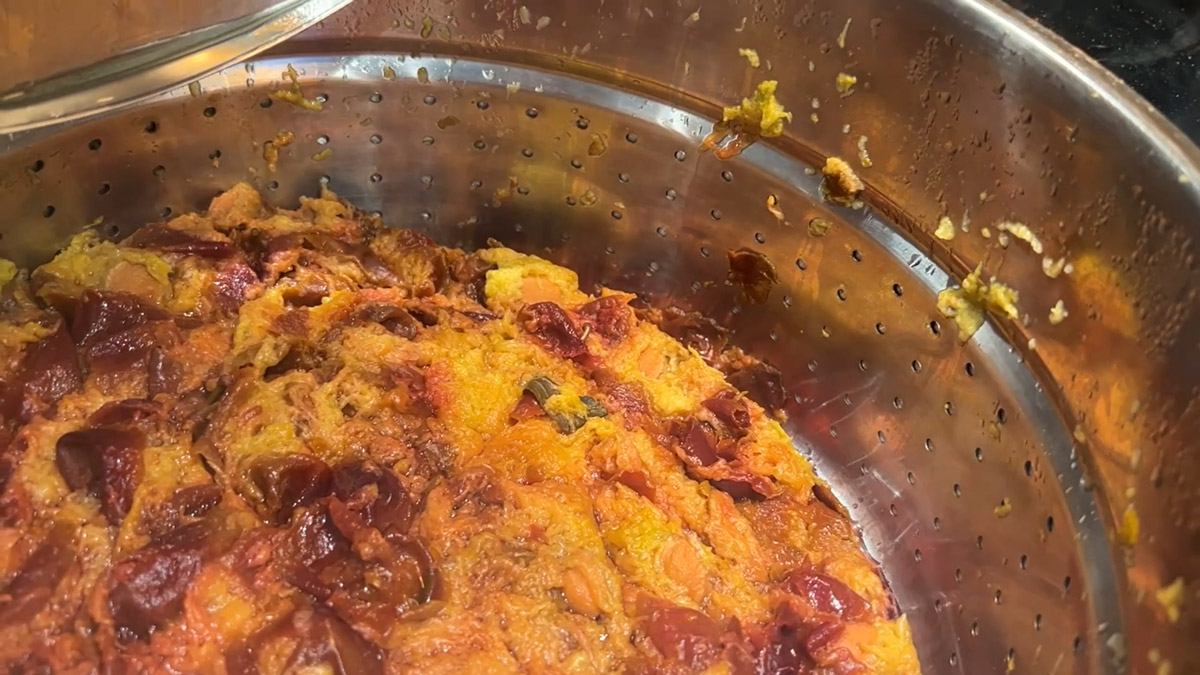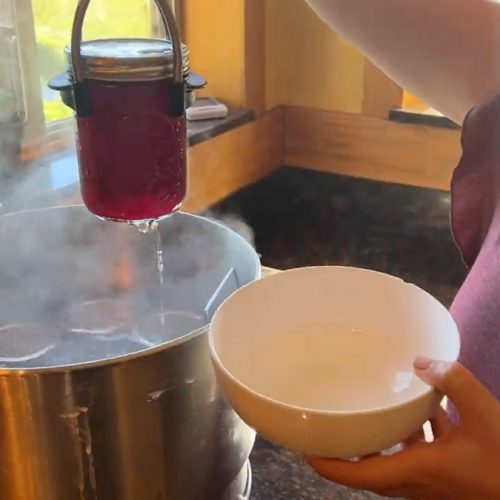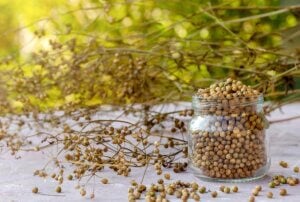


The secret tool that helps us put up a YEAR’S worth of this plum jelly recipe in one day? A steam juicer! Come learn how to make and can this delicious plum jelly made from fresh plums straight off the tree.

Why I Love This Recipe
This recipe is one of my favorites because I can make up a huge batch at a time and can our family’s jelly for the entire year in about half a day of work.
The beauty of this recipe is that you can use this same jelly recipe to make homemade fruit leather in the dehydrator!
I had a lot of helpers for this canning day, but be sure you check out my post on eliminating stress for big preservation days here. It’s filled with great tips for avoiding overwhelm!
Is Plum Jelly Good for You?
Though plum jelly is still fruit juice and sugar, it’s better for you than store-bought jellies because this recipe uses much less sugar.
I wouldn’t classify it as a health food, but when my children make peanut butter and jelly sandwiches, this is certainly a healthier jelly option.

What is Plum Jelly Made of?
Plum jelly is made from the juice of a plum rather than the juice and the pulp as with a jam. It also contains sugar, lemon juice (or citric acid), Pomona’s Pectin and calcium water.
The reason we make plum jelly instead of jam is the time it takes. Using a steam juicer to extract the plum juice saves us nearly two days of labor in the kitchen.

Do Plums Have Lots of Pectin?
Though plums have pectin in their skins, it’s not enough to thicken the jelly without a long boiling time, which changes the flavor and extends the process. This is why we need to add Pomona’s Pectin.

What Does Plum Jelly Taste Like?
Delicious! If you’ve ever bitten into a perfectly ripe plum and had the juice run down your face, you’re close to the taste of plum jelly. Though jelly is a little on the sweeter side due to the added sugar, the flavor is still delightful.

Supplies
- Steam Juicer – A steam juicer is optional, but will eliminate hours of time when extracting the juice from your plums. This is the steam juicer I use and love (in fact, I have two of them!). You can find the steam juicer at Lehman’s as well. Search “Steam Juicer,” then use code “Take20” at checkout to get 20% off.
- Large Stockpot – You’ll need a large stockpot for making the jelly.
- Water Bath Canner – If you don’t have a water bath canner, you can also use a large stockpot. I like this stainless steel canner, but here’s a basic water bath canner that comes with all the canning tools to get you started.
- Canning Tools – Canning tools such as a headspace measuring tool, a jar lifter, a large ladle, and a funnel will come in very handy when canning.
- Mason Jars & Two-Piece Canning Lids – Make sure you have enough clean jars and lids before you start your canning day, or you’ll end up running to the local hardware store last minute like we did!

Ingredients
- Plum Juice – Using a steam juicer really makes this process easy and saves a lot of time. If you don’t have a steam juicer, read below how you can extract the juice from your plums.
- Bottled Lemon Juice or Citric Acid – You must use bottled lemon juice or citric acid for this recipe so you’re reliably adjusting the acid. Freshly squeezed lemons have varying levels of acid and are not reliable when canning.
- Pomona’s Pectin – This is the only kind of pectin we use now because it’s sourced from non-GMO pectin and allows us to reduce the amount of sugar in the recipe for safe canning.
- Calcium Water – Because we’re following a low-sugar recipe, we need to use calcium water and Pomona’s Pectin to help set the jelly. The calcium water comes with Pomona’s Pectin and has directions for use!
- Sugar – The amount of sugar used in this recipe can be adjusted, but you’ll need to follow the directions that come with Pomona’s Pectin to know how to adjust your pectin and calcium water amounts as well.
How To Make Plum Jelly



Make Plum Juice
The first thing you need to do to make plum jelly is to extract plum juice. I like using a steam juicer for this process because it saves hours of time and preparation.
- Add plums, stems, skins, pits and all, to your steam juicer. Allow fruit to steam until there is only pulp remaining (see photo above). Save the pulp for the pigs, chickens or the compost pile!
Homestead Hack: If you don’t have a steam juicer, you’ll want to halve and pit your plums, then place them in a large stockpot with about 1/2 inch of water on the bottom. Bring to a boil and continue to stir and mash the plums to avoid scorching on the bottom of the pot. Strain mashed plums through a fine mesh sieve to collect the juice.



Make Plum Jelly
- Begin with clean jars and all your supplies and ingredients ready to go.
- Mix together lemon juice and calcium water in a bowl.
- Measure out sugar and add pectin into a separate bowl, stir to combine.
- Pour plum juice into a large stockpot over medium to medium-high heat.
- Add lemon juice mixture and stir to combine.
- Bring to a rolling boil then slowly add sugar mixture while stirring continuously to avoid clumping.
- Continue stirring until it reaches a rolling boil again.
- Once your jelly returns to a boil, remove from the heat and begin filling jars.



Canning Plum Jelly
- Prepare water bath canner by filling about ½ way full with water and heating to just below a boil.
- Using a funnel and a ladle, fill clean Mason jars to ¼ inch headspace.
- Wipe the rims of the jars clean with a damp towel and place the canning lid on.
- Add the canning lid band and tighten to fingertip tight.
- Place jars in a water bath canner and bring to a full rolling boil.
- Once the water is boiling, process the jelly for 10 minutes. (Make sure you adjust your processing time if you’re above 1000 ft. elevation!)
- Turn the canner off and remove the lid.
- Let jars sit inside the canner for 10 minutes.
- Remove jars using a jar lifter (and a bowl to catch any drips of water) and place on a towel-lined counter to cool completely, undisturbed, for 24 hours.
- After 24 hours, remove the bands, check the seals, wipe down any sticky residue and label the jars before storing in the pantry.


Homestead Hack: If you’re doing multiple batches of jelly at a time, be sure to wash out the stockpot before adding more jelly ingredients. This will wash out any extra pectin that might be left on the pan, so you don’t over-thicken your jelly.
And there you have it! Easy homemade plum jelly that the whole family will love!
Did you make this recipe? If so, please leave a star rating in the recipe card below! Then snap a photo and tag us on social media @homesteadingfamily so we can see your beautiful jars of plum jelly.

More Posts You May Enjoy
- Homemade Fruit Leather
- Strawberry Rhubarb Jam (With Low Sugar Option)
- The Importance of a Healthy Breakfast
- How Long is Canned Food Good For?
- Preserving Day Tips for Less Overwhelm
- 7 Pantry Staples to Always Have on Hand
- How to Get Ready for Preserving Season
- Homemade Pumpkin Puree

Plum Jelly Recipe
Equipment
- Water Bath Canner
- Large Stockpot
- Mason Jars & Lids
- Canning Tools (jar lifter, funnel, ladel, headspace measurer)
Ingredients
- 1 gallon plum juice
- 1 cup lemon juice (bottled)
- 5.3 tablespoons calcium water (5 tablespoons plus 1 teaspoon – comes with Pomona's Pectin)
- 8 cups sugar
- 1/4 cup Pomona's Pectin
Instructions
For Plum Juice (with Steam Juicer)
- Add plums to a steam juicer. Allow fruit to steam until there is only pulp remaining. Save the pulp for the pigs, chickens or the compost pile!
For Plum Juice (without Steam Juicer)
- Halve and pit your plums, then place them in a large stockpot with about 1/2 inch of water on the bottom.
- Bring to a boil and continue to stir and mash the plums to avoid scorching on the bottom of the pot.
- Strain mashed plums through a fine mesh sieve to collect the juice.
For Plum Jelly
- Begin with clean jars and all your supplies and ingredients ready to go.
- Mix together lemon juice and calcium water in a bowl.
- Measure out sugar and add pectin into a separate bowl, stir to combine.
- Pour plum juice into a large stockpot over medium to medium-high heat.
- Add lemon juice mixture and stir to combine.
- Bring to a rolling boil then slowly add sugar mixture while stirring continuously to avoid clumping.
- Continue stirring until it reaches a rolling boil again.
- Once your jelly returns to a boil, remove from the heat and begin filling jars
Canning Plum Jelly
- Prepare water bath canners by filling about 1/2 way full with water and heating to just below a boil.
- Using a funnel and a ladle, fill clean Mason jars to 1/4 inch headspace.
- Wipe the rims of the jars clean with a damp towel and place the canning lid on.
- Add the canning lid band and tighten to fingertip tight.
- Place jars in a water bath canner and bring to a full rolling boil.
- Once the water is boiling, process the jelly for 10 minutes (or 15 minutes if you’re above 1000 ft. elevation).
- Turn the canner off and remove the lid.
- Let jars sit inside the canner for 10 minutes.
- Remove jars using a jar lifter (and a bowl to catch any drips of water) and place on a towel-lined counter to cool completely, undisturbed, for 24 hours.
- After 24 hours, remove the bands, check the seals, wipe down any sticky residue and label the jars before storing in the pantry.
Notes
- A steam juicer will save you hours of time for this recipe. I highly recommend it!
- If you’re making multiple batches of jelly, be sure to wash the stockpot clean between batches so you don’t end up with too much pectin in your plum jelly recipe.


















